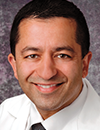Badhwar Team Shows Mitral Valve Repair Is Safe, Effective for Elderly Patients Previously Considered Too High Risk
Heart surgery to repair the mitral valve is safe and leads to a better quality of life for older patients long suspected to be too high risk for the operation, according to research from the University of Pittsburgh School of Medicine.
The results, available online and published in the December 2012 issue of the Annals of Thoracic Surgery, provide much-needed data on patients 65 years and older that could guide future treatment recommendations for people with severe heart disease.
“It is widely accepted that mitral repair is the treatment of choice for people with severe heart disease caused by a leaking mitral valve, and it can restore life expectancy to normal,” said Vinay Badhwar, a professor of surgery at Pitt, codirector of the UPMC Center for Mitral Valve Disease, and chief of cardiac surgery at UPMC Presbyterian hospital. “However, in older patients, current guidelines recommend initial medical management of the disease, delaying surgery until symptoms are very advanced. In some cases, delays in surgery can lower quality of life and make the eventual surgery riskier as the patient’s health further deteriorates.”
the UPMC Center for Mitral Valve Disease, and chief of cardiac surgery at UPMC Presbyterian hospital. “However, in older patients, current guidelines recommend initial medical management of the disease, delaying surgery until symptoms are very advanced. In some cases, delays in surgery can lower quality of life and make the eventual surgery riskier as the patient’s health further deteriorates.”
Badhwar and his team collected national data on 14,604 people age 65 and older who had mitral valve repair operations between 1991 and 2007. They examined rates of mortality, reoperation, and readmissions for heart failure, bleeding, and stroke.
Less than three percent of the patients, who had an average age of 73, died during surgery. The five-year survival rate was nearly 75 percent. One of the most important findings was that following mitral repair, the 10-year survival rate was more than 57 percent, comparable to the average age-matched U.S. population without heart disease. Five years after surgery, 3.7 percent of the patients had to have another mitral valve operation; 18.4 percent experienced heart failure; 7.2 percent were readmitted for bleeding; and 7.7 percent had a stroke. Readmissions were most common in patients who had surgeries late in their illness from mitral valve disease.
“Our data show that not only is mitral valve repair a safe option for elderly patients because of its excellent early outcomes and the low incidence of late stroke and bleeding, but it also is a well tolerated and lasting solution for the treatment of severe heart disease,” Badhwar said. “This information will improve medical guidelines to emphasize the importance of timely referral of older patients for mitral valve surgery.”
The mitral valve lies between the atria and ventricles of the heart and helps control blood flow. When it malfunctions, blood doesn’t flow the way it should, which can lead to congestive heart failure. Symptoms include shortness of breath and decreased ability to endure physical activity.
Benefits of promptly repairing the mitral valve include preservation of heart function, leading to an improved quality of life; less need for reoperation; lower operative mortality; and improved long-term survival. It also can lead to a lower likelihood of readmission for heart failure, a globally important health care issue as costs associated with readmissions continue to climb.
“The baby boomer generation will be entirely over age 65 by 2030, making it critical that we research and promote therapies that can influence long-term, hospital-free survival of older people,” Badhwar said. “Such measures will have lasting health care implications and allow hospitals to best manage their resources.”
The research was supported by The Society of Thoracic Surgeons Research Center through the Adult National Cardiac Database.
Other Stories From This Issue
On the Freedom Road

Follow a group of Pitt students on the Returning to the Roots of Civil Rights bus tour, a nine-day, 2,300-mile journey crisscrossing five states.
Day 1: The Awakening
Day 2: Deep Impressions
Day 3: Music, Montgomery, and More
Day 4: Looking Back, Looking Forward
Day 5: Learning to Remember
Day 6: The Mountaintop
Day 7: Slavery and Beyond
Day 8: Lessons to Bring Home
Day 9: Final Lessons

